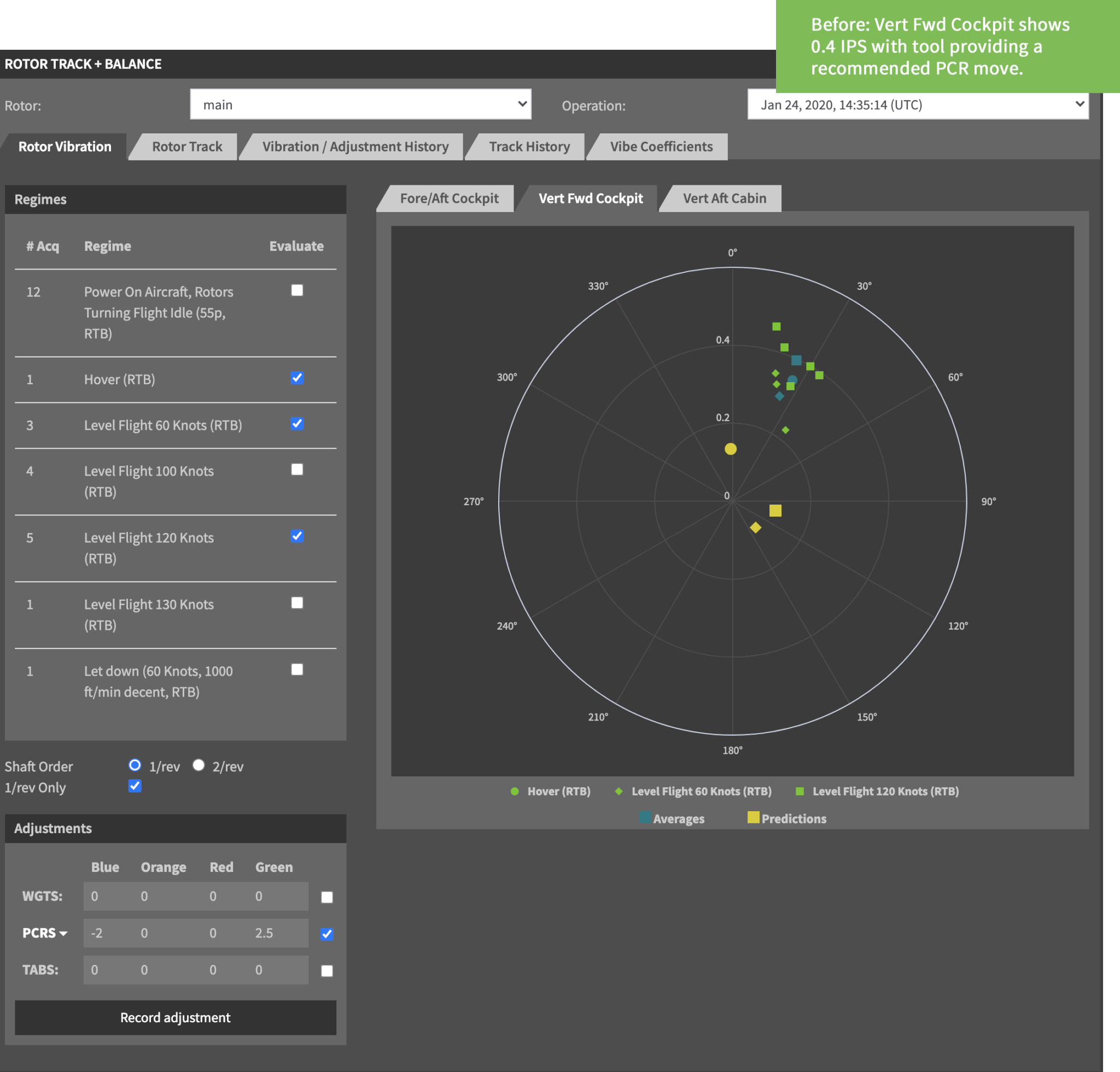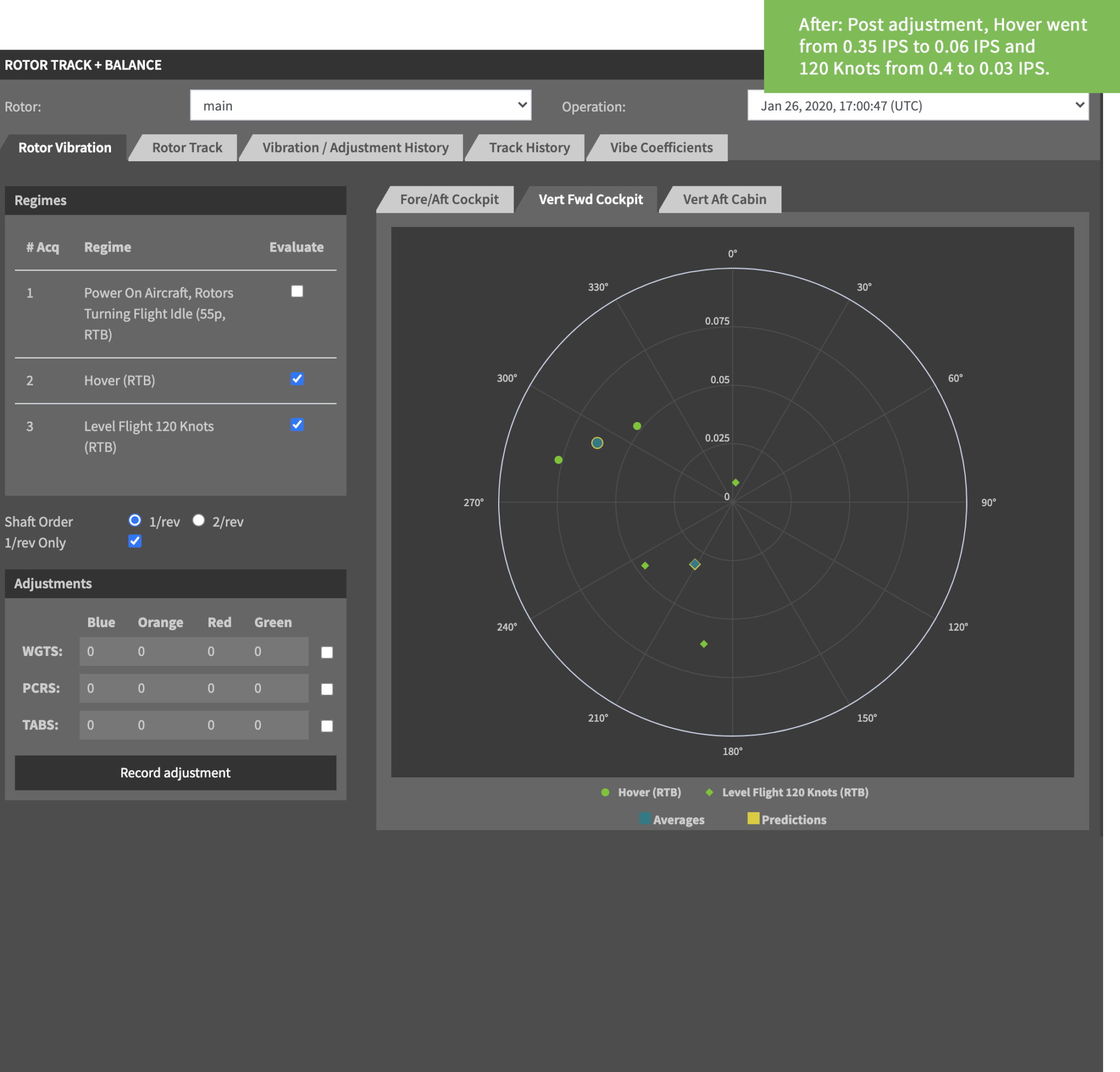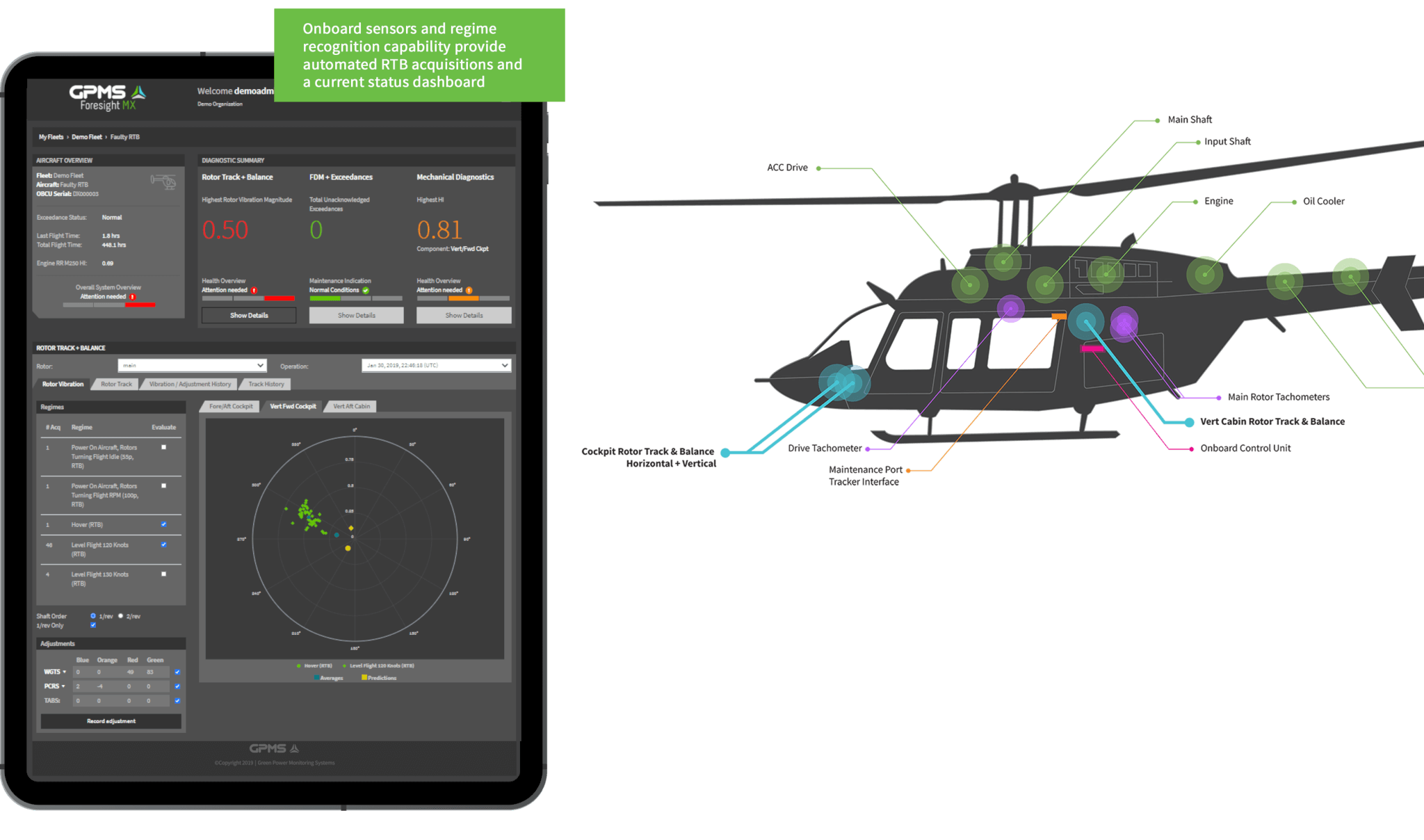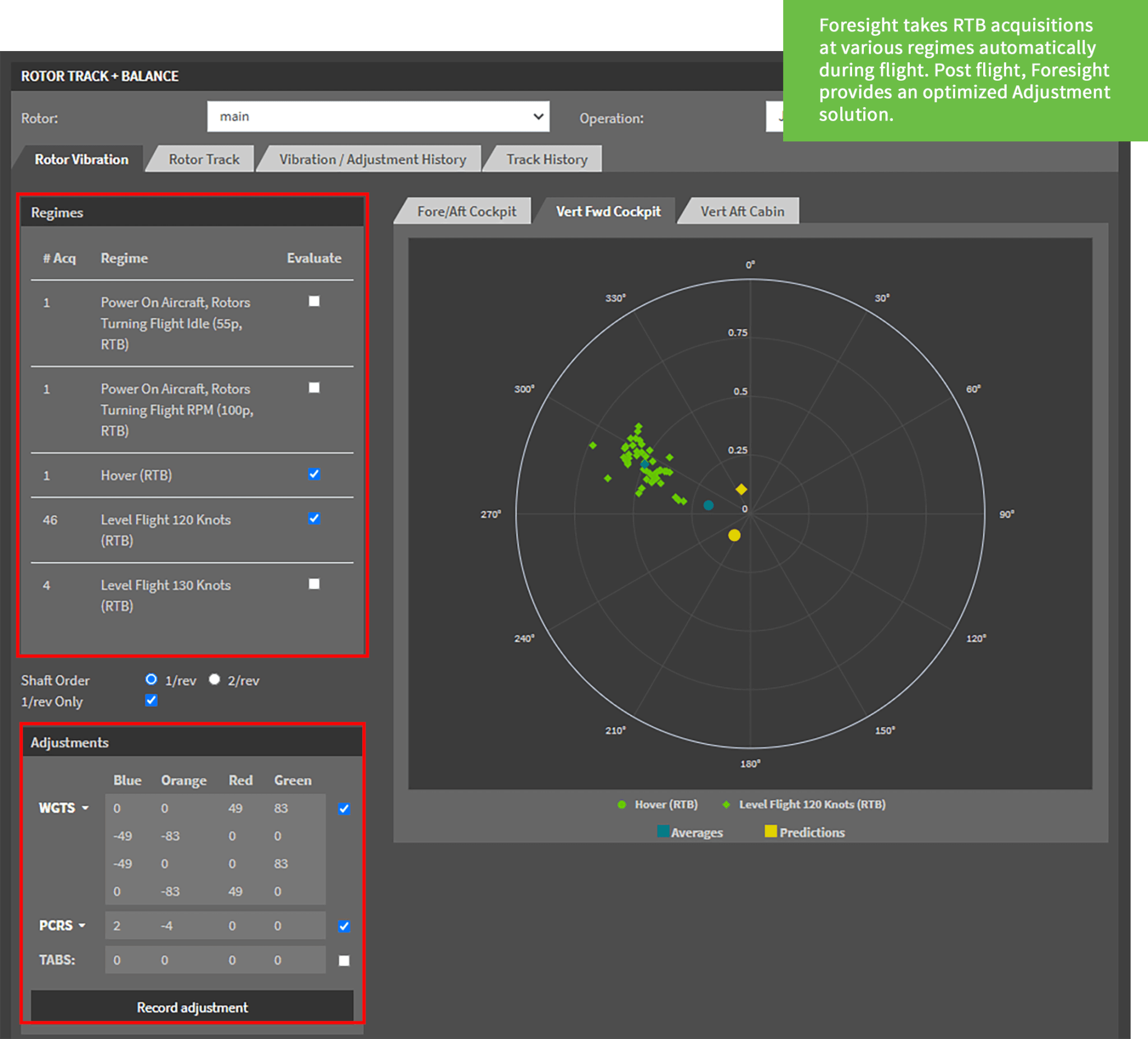
Helicopter RT&B case study
The head of a major MRO once told us, “Before I got into rotorcraft, I had no appreciation for the amount of time and energy that is spent on rotor track and balance.”
At GPMS, we’ve seen this time and again. While aircraft dependent, many of our customers report spending several days per year entirely on RTB: attaching specialized equipment, taking dedicated flights to manually acquire readings, making adjustments, then re-flying the aircraft to validate the solution. Often this sequence is repeated multiple times.
Foresight is designed to change this paradigm. And according to David Poe, maintainer of a Bell 407GX at Hill Air in Texas, the system delivers: “The system automatically provides a solution every time the aircraft lands. To be honest, at first, I didn’t have confidence that it would be so easy — that the moves the system suggested would do the job. Now I’m a believer.”
Making A Believer Out of David Poe
In late 2019, Poe got a high vibration alert via Foresight’s push email notification system. Vert Fwd Cockpit was showing 0.4 IPS, an orange level measurement corresponding to ‘Attention needed’ in our dashboard display.
Poe opened his PC and logged into Foresight. He saw that vibration for Hover, 60 Knots, and 120 Knots were all similar so he decided to implement a PCR adjustment. He unselected WEIGHTS and TABS, and Foresight’s algorithm presented a new solution: -2 flats on Blue, + 2.5 flats on Green. Significantly, Foresight predicted (yellow shapes on the polar plot) this move would bring IPS down below .1 IPS.

At this point Poe was doubtful. In his experience, RTB was a multi-move, iterative process that required several maintenance flights. But, with encouragement from GPMS customer support and Greg Arnold from the Bell Customer Engineering Team, Poe moved forward.
After the adjustment was made, Dave did a test flight to verify the movement’s effect. While we don’t typically recommend dedicated RTB test flights, given that it was Poe’s first use of Foresight’s optimized recommendation, we encouraged him to validate the solution. Happily, the average for Hover went from 0.35 IPS to 0.06 IPS, and for 120 Knots: 0.4 to 0.03 IPS. (Note the changed scale on the polar plot.) His Bell 407 was now super smooth!

How We Do It — Foresight’s Approach to RTB
Stepping back from this specific case, there are three core components to Foresight’s RTB solution.
Component 1 – Install an ‘Always On’ System
In contrast to many RTB solutions, which require dedicated installation (and then removal) for maintenance, Foresight is always installed and always on. See picture below for a complete schematic showing dedicated RTB sensors. The result is a system that continually monitors the aircraft, including its rotor balance in inches per second (IPS).

Component 2 – Acquire Regime Data Automatically During Normal Flight Operations
Foresight’s regime recognition capability enables operators to capture data automatically as the aircraft passes through various states, including Power On Aircraft Rotors Turning Idle, Power On Aircraft Rotors Turning Flight, Level Flight 100 Knots, Level Flight 120 Knots, Level Flight 130 Knots, and Let Down. The system averages 30 RTB acquisitions per hour when flying in an RTB regime. (By contrast legacy HUMS systems take 3-6 per hour.) Operators can also enter an RTB maintenance mode to collect approximately 4 acquisitions per minute in a user-triggered regime.
Component 3 – Postflight, Get An Optimized RTB Solution and Modify As Desired
Dependent on your aircraft type, select your Rotor System (Main/Tail/Twin/Contra) and RTB Activity (Rotor Vibration or Rotor Track). Then review and confirm the flight regimes you’ve evaluated for the solution.You can review Foresight’s adjustment solution using your judgment as a maintainer. Checkboxes allow maintainers to select or restrict adjustment types and dropdown arrows display alternative adjustment options.

The Takeaway – Operator Benefits & ROI
From Rotor Balancing to Rotor Smoothing
Many operators, particularly those dependent on MROs, will perform RTB several times per year. They will adjust the aircraft and over time the balance will deteriorate, the IPS gradually ticking upward. Months may go by in which the aircraft is flying in the range of .1 to .5.
Because Foresight reduces RTB associated work so dramatically, operators can move from RTB balancing to smoothing, making smaller more frequent adjustments that improves overall fleet performance. One operator, with four 407s in their fleet, has used Foresight to dramatically change their approach to RTB in the last year. The result? The fleet has an average vibration level of 0.08 IPS.
Benefit of Balance: Comfort, Fuel Savings, and Long Term Cost Reduction
But what benefit do smooth rotors provide? First and foremost, passenger comfort, which in the case of pilots has been directly correlated with fatigue. Second, fuel savings. It’s been estimated that smooth rotors will save 1% on fuel. Third, lower long term maintenance costs. A smooth rotorcraft shakes less, doing less damage over time to its component parts, which translates into savings. In fact, in one large scale US Airforce study, where vibration levels between a studied and control group were reduced by 54%, the overall failure rate was reduced by 48% and life-cycle costs showed a reduction of approximately 10% per aircraft.*
The Numbers: Direct & Consequential ROI
In 2019, GPMS worked with Conklin & de Decker to develop a customizable ROI model that enables operators to plug in their specific aircraft model, revenue drivers, and costs and calculate the financial benefits of the Foresight HUMS. As you can see below, compared to standard practice, on a Bell 407GX Foresight saves $7,644 annually in direct RTB related costs alone.

Significantly, though, this estimate calculates only the direct savings benefit of using Foresight compared to the alternative. It does not calculate the incremental benefit of passenger comfort, fuel savings, or the improved cost profile of an aircraft optimally balanced. When you bake these consequential benefits in, we believe the total RTB related savings stretch well north of $10,000 annually.
For David Poe, though, its not only about dollars and cents: “Foresight makes RTB really easy. The system saves me time and helps our aircraft run smoother. And I know that’s going to make a real impact on our aircraft maintenance long term.”
To learn more about Foresight’s Rotor Track and Balance capabilities and to get an ROI report specific to your fleet, contact us below.
